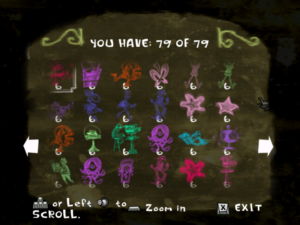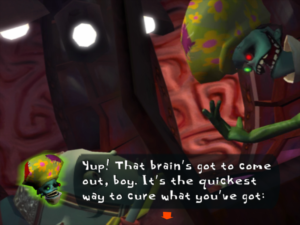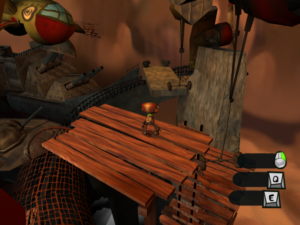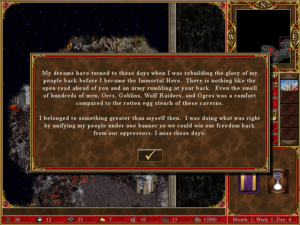Psychonauts: Style
 One thing I like a lot about Psychonauts is its variability of style. Each mental world is a representation of one character’s mind, and conforms to that character’s world view, with greater or lesser degrees of abstraction and phantasmagoria mixed in. One person has decided to treat life as an endless party, and has a mind decorated like a discotheque. Another is paranoid, and has a mental landscape that’s fragmented into disjointed sidewalks floating in the abyss in varying orientation, lined with tract houses, a veneer of normality that completely fails to conceal the bizarre. One guy’s inner world is rendered in imitation of the paintings he does. Since his medium is fluorescent paint on black velvet, this makes for the strongest visual shift yet.
One thing I like a lot about Psychonauts is its variability of style. Each mental world is a representation of one character’s mind, and conforms to that character’s world view, with greater or lesser degrees of abstraction and phantasmagoria mixed in. One person has decided to treat life as an endless party, and has a mind decorated like a discotheque. Another is paranoid, and has a mental landscape that’s fragmented into disjointed sidewalks floating in the abyss in varying orientation, lined with tract houses, a veneer of normality that completely fails to conceal the bizarre. One guy’s inner world is rendered in imitation of the paintings he does. Since his medium is fluorescent paint on black velvet, this makes for the strongest visual shift yet.
I think my favorite so far is the inner world of Fred Bonaparte, a classical loonie who thinks he’s Napoleon. Sort of. It’s more like he’s got a split personality and one of those personalities is Napoleon. (Or, heck, maybe he really is possessed by Napoleon’s ghost. It wouldn’t be the weirdest thing in the game.) In his mind, Fred and Napoleon are playing a hex-based wargame, which you can descend into and explore at two different levels of scale, shifting in size as appropriate to interact with the buildings on the map or the wooden soldiers. (Both soldiers and buildings occupy one hex each.) With the size shifts and the conversing with game pieces, it’s kind of like Alice in Wonderland meets Avalon Hill. And, well, the game just looks good. It’s that lush mixture of gameboard and diorama that the really dedicated hobbyists put together, the sort of thing that makes you want to learn the rules just so you’ll be allowed to touch it.
I suppose that switching around the look from level to level is really one of the fundamental techniques behind platformers: it’s a way to create variety when the gameplay has limited range. Not that this is much of an issue here.
 Comments(1)
Comments(1)





